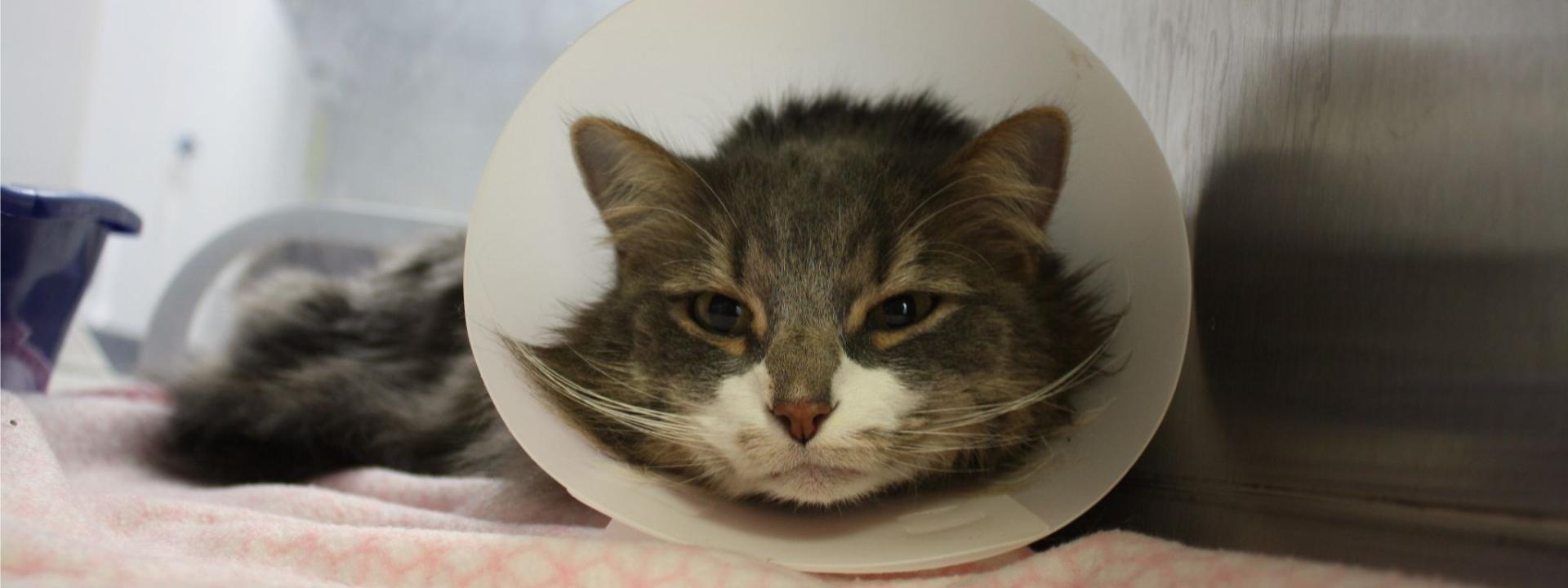Most cats will scratch on occasion but if you notice that the occasional scratch and regular grooming turns into a cat who appears uncomfortable, skin problems may be present and you should schedule an appointment with one of the veterinarians here at Hallett Veterinary Hospital.
Excessive scratching, hair loss, and a mildly frantic cat are signs that skin problems may be present and your feline friend needs medical attention. While skin problems are rarely an emergency, an uncomfortable cat will have trouble enjoying daily life until those symptoms are under control.
In comparison to dogs, cats typically require less care for their coats and skin. Dermatologic treatments in cats are much less common than in dogs. By performing a weekly brushing, you will be familiar with your cat’s coat and skin and will be more likely to catch any potential skin problems early on and bring it to the attention of your veterinarian.
Recognizing Feline Skin Conditions
So how do you recognize skin conditions? Here are some key signs to look for:
- Hair loss is a common sign of skin problems. Have you noticed any bald patches? Is your cat shedding more than normal?
- Excessive grooming can also indicate skin conditions are present. If the grooming appears more frenetic and less relaxed than normal, it may be because your cat is pruritic (itchy) and uncomfortable.
- While brushing your cat, if you notice any red, scaly, patchy, or scabby areas, schedule an appointment with your veterinarian.
- Fleas and ticks are common parasites that may be found on the skin.
- If your cat shakes his head excessively or is itching at their ears, this could indicate a skin problem or an issue with ears.
Types of Feline Skin Conditions
The following are some types of common cat skin problems you should be aware of:
- Fleas can cause itchy skin and sometimes dermatitis. The cat can sometimes then scratch and bite and potentially cause secondary infections.
- Ticks can attach to your cat’s skin causing a raised bump or cause localized swelling.
- Ear mites can produce itchy ears. This is more commonly seen in kittens. The cat can hold his head sideways indicating discomfort.
- Ear infections are overgrowth of bacteria and/or yeast that need to be treated promptly by your veterinarian.
- Ear polyps are benign growths in the ear canal. A thorough exam with an otoscope of the cat’s ear canal is required to diagnose this.
- Food allergies: Your cat can develop an “itchy face,” or itchiness all over. Your veterinarian will determine if you need to change your cat’s diet. This will generally include a food trial for 8-12 weeks that is strict and may require several attempts to rule out food allergy.
- Contact allergies: This is very similar to how people develop allergies to common substances in their environment.
- Skin cancer: As in humans, cancer is a potentially life-threatening condition. If you notice new or changing skin masses, make a veterinary appointment ASAP.
- Feline acne: Some cats are prone to chin acne. While this may appear similar to a rash, the treatment of acne may involve prescription medication.
- Dermatitis can be from a variety of causes including but not limited to an allergic reaction to grooming products, food or environmental irritants.
Schedule an appointment with your veterinarian as soon as you see any of these symptoms.
Testing and Diagnosing Skin Problems
Your veterinarian has many types of tests available when it comes to feline dermatology issues:
- One common test is to collect some of the material in the ear and look at it under a microscope (ear cytology).
- Your vet can also take a small scraping of the hair follicles or the debris on the skin and look at it under a microscope. They will be looking for mites, yeast or bacteria or certain types of cells to determine the cause of the discomfort.
- A fungal culture can check for ringworm which can be transmitted to other animals, children, or adults.
- A skin biopsy can also be helpful in some cases, especially if the veterinarian is worried about cancers or immune mediated skin issues.
There are many things your veterinarian will be looking at to determine what is the most appropriate treatment.
Treatments for Skin Issues
Getting a diagnosis from your veterinarian is the first step.
- If you are dealing with fleas, your vet will recommend flea control medications.
- If you are dealing with food allergies, your vet may have to switch your cat’s food.
- Your vet may have to use an immune-modulating medication to suppress allergic response in your cat.
- Anti-itch medications may be used to make your cat feel more comfortable.
- If ringworm is present, antifungal medication will be prescribed.
- Some medications must be injected by a veterinarian while other medications can be administered orally by you at home.
It is important that you work with your veterinarian to accurately describe your cat's symptoms . Then, your vet will perform a thorough exam and recommend the appropriate diagnostics and treatment.
Schedule A Feline Dermatology Appointment
Make sure to reach out to your veterinarian as soon as you notice any changes in your cat’s grooming behavior, excessive itchiness, or if you notice red, scaly patches or scabs on your cat’s skin. Skin conditions can quickly worsen, becoming more difficult and costly to treat. Early detection and treatment are important.

